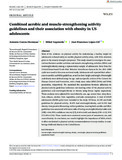Combined aerobic and muscle-strengthening activity guidelines and their association with obesity in US adolescents
Fecha
2023Versión
Acceso abierto / Sarbide irekia
Tipo
Artículo / Artikulua
Versión
Versión publicada / Argitaratu den bertsioa
Impacto
|
|
10.1111/sms.14504
Resumen
Most of the evidence on physical activity for maintaining a healthy weight in adolescents is based solely on aerobic physical activity alone, with little attention given to the muscle strength component. This study aimed to investigate the associations between aerobic activities and muscle-strengthening activities (MSA) and overweight/obesity among a representative sample of adolescents. Data fro ...
[++]
Most of the evidence on physical activity for maintaining a healthy weight in adolescents is based solely on aerobic physical activity alone, with little attention given to the muscle strength component. This study aimed to investigate the associations between aerobic activities and muscle-strengthening activities (MSA) and overweight/obesity among a representative sample of adolescents. Data from the United States-based Youth Risk Behavior Surveillance System for the 2011–2019 cycle were used in this cross-sectional study. Adolescents self-reported their adherence to aerobic and MSA guidelines, as well as their height and weight. Overweight and obesity were defined using the age- and sex-specific criteria of the Centers for Disease Control and Prevention, with a body mass index (BMI) ≥85th and ≥95th percentiles, respectively. We examined the associations between adherence to physical activity guidelines (reference: not meeting either of the physical activity guidelines) and overweight/obesity or obesity using binary logistic regressions. These analyses were adjusted for race/ethnicity, sex, age, screen time, sleep duration, tobacco, alcohol, fruit, vegetables, and soda consumption. A total of 42 829 adolescents (48.98% girls) were included in the study. Of these, 22.23% met both guidelines for physical activity, 30.47% had overweight/obesity, and 14.51% had obesity. Compared with meeting neither guideline, meeting both aerobic and MSA guidelines was associated with lower odds of having overweight/obesity (odds ratio [OR] = 0.64, 95% confidence interval [CI], 0.60 to 0.68) and obesity (OR = 0.52, 95% CI 0.48 to 0.56). These results were consistent across years of assessment, sex, and race/ethnicity. In conclusion, our results highlight the importance of MSA, which is often overlooked in physical activity recommendations in many studies, in combating childhood obesity in the United States. [--]
Materias
Excess weight,
Muscle strength training,
Obesity,
Overweight,
Physical activity guidelines,
Population based
Editor
Wiley
Publicado en
Scandinavian Journal of Medicine and Science in Sports 2023
Departamento
Universidad Pública de Navarra. Departamento de Ciencias de la Salud /
Nafarroako Unibertsitate Publikoa. Osasun Zientziak Saila
Versión del editor
Entidades Financiadoras
Open access funding provided by Universidad Pública de Navarra.




